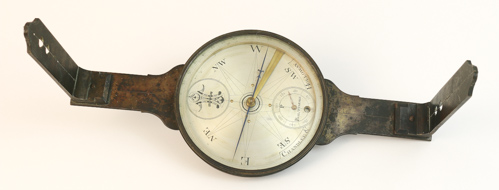eReference Library

Thomas Greenough Compass - Circa 1760 - Bud Uzes Collection
Survey Compasses
Surveying was an early necessity for pre-1800 colonial Americans, and almost all the surveying was done with a compass and chain. Many compasses were made out of wood (especially in New England) with a paper compass card. Brass was more expensive, could be difficult to acquire, and there were not many craftsmen in America who had the requisite skill to produce a metal based surveying compass. By 1800, however, as brass became cheaper and the number of craftsmen increased, brass replaced wood as the compass of choice. Few if any wood compasses were made after 1825.
Brass compasses come in two flavors - plain and vernier (sometimes called nonius before 1900).
Wood surveying compass are a wonderful collectible. Wood compasses are hard to find - they are not nearly as durable as brass compasses. But they were made in sufficient quantity, especially in the Northeast, so it is possible to find a wood compass occassionally. The paper compass cards can be very artistic - and Paul Revere is thought to have printed some of them, including for the compass pictured above. Click here for a good look of the compass card.
Plain compasses rely solely on the magnetic needle for determining direction. Craftsmen started producing large surveying plain compasses made out of brass starting in about 1730. A highly skilled craftsman could produce a compass face that was a work of art (like the compass above). Compare this compass face to perhaps the oldest surviving large surveying brass compass - circa 1730 to 1740.
Plain compasses, especially eighteenth century plain compasses, oftentimes did not have levels on the arms. An expensive add-on no doubt, and perhaps considered unnecessary by some buyers. For example, while not having levels, the about compass had a sophisticated chain counter.
Vernier Compasses were invented in the second half of the 18th century. The magnetic needle points in the direction of the magnetic north pole, which moves around in a predictable fashion. A Vernier compass has a means for setting off the amount of magnetic variation so that bearings can be based upon true north rather than the magnetic north (which is shifting constantly). In the compass pic above, you can see the vernier right under the "N".
Early vernier compasses are relatively rare, and therefore worth more than plain compasses. Most large surveying compasses produced by the late 19th century were of the vernier variety.
Railroad Compasses
The railroad compass is basically the same instrument as the vernier compass except it has the added feature of a graduated circle for reading horizontal angles independently of the needle. Its operation is similar to the surveyor's transit, except that it lacks a telescope and vertical circle. Few railroad compasses are known today, suggesting their use was quite limited. Most surveyors probably preferred having the added advantage of a telescopic sight to the open sighting vanes.
Here is a Gurley Railroad Compass, where you can see the mechanism underneath that allowed the surveyor to take horizontal measurements. Basically the surveyor would point the compass sights at the first location, lock one plate of the compass in place, and then rotate the rights to the second location. The surveyor could then determine the angular difference between the two locations very accurately. Click here to see Gurley Railroad Compass.
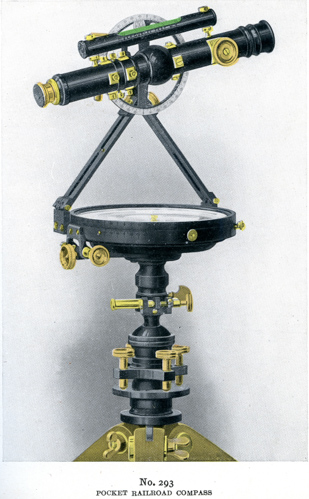
Gurley also made a smaller railroad compass, and put a telescope on it as well. A very desirable item - and hard to find.
Pocket Compasses
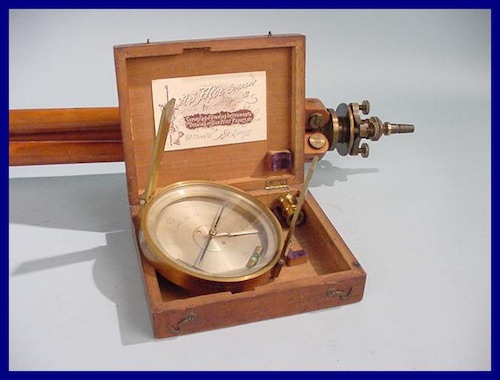
A number of makers produced Pocket Compasses. These compass were typically very small and light. The Gurley Pocket Compass pictured to the left typically came with a needle 2.5in, 3.5in, or 4 inches long. As Gurley indicates in its 1862 Instrument Manual at page 122, surveyors did not use pocket compasses in extensive surveys like the larger vernier and plain compasses. According to Gurley, however, surveyors found pocket compasses to be very convenient in making explorations and in retracing the lines of government surveyings. Pocket Compasses cost only about 1/4 as much as a large surveyors compass.
Compasses Were the Instrument of Choice in America from 1700 to 1865
Surveyor Compasses owned the instrument market from colonial times until William Young invented the Transit in 1831. While there is no meaningful surveying instrument production data until the 1850s, it is extremely likely that large compasses outsold transits from 1831 until after the civil war ended. Transits were much more expensive than compasses, which likely explains why it took transits nearly 4 decades to outsell compasses. Looking at a Gurley Instrument Manual for 1859 (pages 1-3), for example, a Gurley Vernier Compass was about 1/3 the price of a transit, while a Gurley Railroad compass (that could measure angles like a transit) was roughly 1/2 the price.
The Gurley Instrument Manual for 1858 (at page 5) contains very interesting production data for 1857. Gurley states that it produced 295 large surveying instruments in 1857:
110 Vernier Compasses
11 Railroad Compasses
17 Plain Compasses
42 Engineers' Transits
56 Surveyors' Transits
30 Vernier Transits
29 Levels
Thus, as late as 1857, Gurley, one of the leading instrument makers in America, sold more compasses (138) than transits (122).
Resources for Compass Collectors
You need two books if you are going to collect large surveying compasses made from 1700 to 1850 - Smart's "Makers of Surveying Instruments" and Bedini's "Early Scientific Instruments". You can download the digital versions of both books below (I scanned Smart's book myself, as the copyright has expired).
For compasses made after 1850, the best place to look at the individual instrument maker's catalogues (click here) or go to my Instrument Makers Webpage.
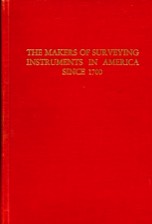
Smart's "The Makers of Surveying Instruments in America Since 1700" is the Magnum Opus of the field. First published in 1962, Smart added a second volume with new information in 1967 (with the 1962 edition becoming Vol 1). So you can hunt down the 1962 vol 1 and 1967 vol 2, or Smart also sold a single book with both volumes combined in 1967. You need this book if you're going to buy early American compasses. I scanned my copy - word searchable, but 65MB file.
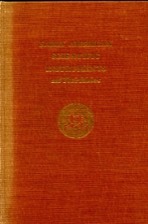
Bedini's "Early American Scientific Instruments" is a 184 page book published in 1964 with hardback and paper cover versions. Not as comprehensive as Smart's book, but with numerous high quality photos of compasses and some other instruments. Bedini's book has been preprinted, but typically the reprinters used much cheaper paper, and the pictures in the book lost a meaningful amount of detail. So download the pdf below, or if you want a hardcopy, buy the rather inexpensive original versions, either paperback (roughly $25) or hardback (roughly $50). I have some of these books if you need one.
© 2020 Russ Uzes/Contact Me

